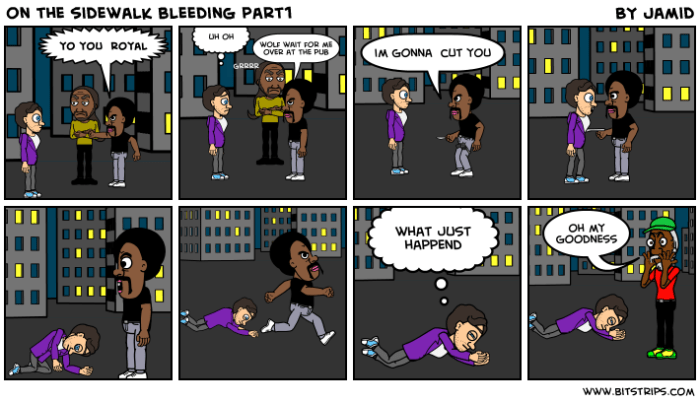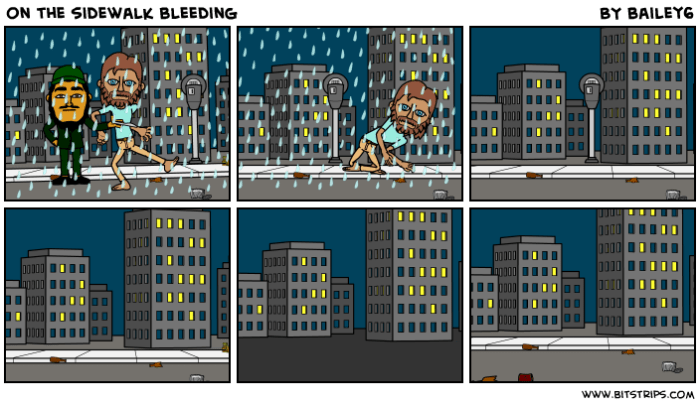On the Sidewalk Bleeding PDF delves into the sobering reality of individuals found bleeding on the sidewalk, exploring the underlying causes, societal implications, and the urgent need for awareness and prevention.
This comprehensive guide sheds light on the medical, legal, and social aspects of this prevalent issue, providing a deeper understanding of the complexities involved.
Introduction: On The Sidewalk Bleeding Pdf
The term “on the sidewalk bleeding pdf” refers to a specific document or publication that addresses the topic of being injured and bleeding on a sidewalk. This topic is significant because it relates to personal safety, liability, and the responsibility of property owners to maintain safe walkways.
The prevalence of this topic is evident in the numerous legal cases, insurance claims, and public safety campaigns that focus on preventing and addressing injuries sustained on sidewalks.
Causes and Consequences
Individuals found bleeding on the sidewalk may have experienced various causes, leading to significant physical, emotional, and societal consequences.
Potential Causes
The causes of an individual being found bleeding on the sidewalk can be diverse, ranging from accidents to intentional acts of violence.
- Accidents:Falls, slips, or collisions can result in injuries that cause bleeding.
- Assaults:Physical altercations or attacks can lead to severe injuries, including bleeding.
- Medical Conditions:Certain medical conditions, such as uncontrolled bleeding disorders or head injuries, can cause individuals to bleed profusely.
- Self-Harm:Intentional self-inflicted injuries can result in significant bleeding.
Consequences
The consequences of being found bleeding on the sidewalk can be severe and multifaceted.
Physical Consequences
- Blood Loss:Excessive bleeding can lead to anemia, shock, or even death.
- Pain and Discomfort:Injuries causing bleeding can be painful and uncomfortable.
- Infection:Open wounds can become infected, leading to further health complications.
Emotional Consequences
- Trauma:Witnessing or experiencing bleeding can be traumatic, causing anxiety, fear, or post-traumatic stress disorder (PTSD).
- Stigma:Bleeding in public can lead to negative perceptions or stigma, affecting an individual’s self-esteem and social interactions.
- Emotional Distress:The physical pain and trauma associated with bleeding can cause significant emotional distress.
Societal Consequences
- Public Safety:Bleeding individuals on sidewalks can create a public safety hazard, especially if they are unresponsive or disoriented.
- Healthcare Costs:Treating injuries that cause bleeding can be expensive, burdening healthcare systems.
- Social Impact:The sight of someone bleeding in public can disrupt the community and create a sense of unease.
Medical and Legal Considerations

When encountering an individual bleeding on the sidewalk, understanding the medical and legal implications is crucial. This section provides an overview of the medical procedures and treatments involved, as well as the legal responsibilities of individuals involved in such a situation.
Medical Procedures and Treatments
Upon discovering an individual bleeding on the sidewalk, it is imperative to assess the severity of the injury and seek immediate medical attention. The initial response should focus on controlling the bleeding and preventing further complications.
- First Aid Measures:Apply direct pressure to the wound to stop the bleeding. Use clean gauze or a cloth and maintain pressure for several minutes.
- Professional Medical Treatment:If the bleeding persists or the injury is severe, call for emergency medical services. Medical professionals will assess the wound, clean it, and apply appropriate dressings or sutures to promote healing.
- Ongoing Care:Depending on the severity of the injury, ongoing medical care may be necessary, including antibiotics to prevent infection, pain medication, and physical therapy for rehabilitation.
Social and Community Impact
Individuals found bleeding on the sidewalk often face social stigma and discrimination. They may be perceived as homeless, addicts, or criminals, leading to fear and avoidance from the public.
Community organizations and support groups play a crucial role in providing assistance and resources to these individuals. They offer medical care, shelter, counseling, and other services aimed at addressing their immediate needs and long-term well-being.
Social Stigma and Discrimination
- Fear and avoidance due to perceived homelessness, addiction, or criminality.
- Lack of understanding about underlying medical conditions or social factors.
- Negative stereotypes and biases perpetuated by media and society.
Role of Community Organizations and Support Groups
- Provision of medical care, shelter, and counseling services.
- Advocacy for individuals’ rights and access to resources.
- Education and awareness campaigns to reduce stigma and promote empathy.
Prevention and Awareness

Educating the public about the dangers and consequences of being found bleeding on the sidewalk is crucial. This includes raising awareness about the potential causes, risks, and available resources for assistance. To achieve this, a comprehensive public awareness campaign should be designed and implemented.
Public Awareness Campaign, On the sidewalk bleeding pdf
* Develop educational materials, such as brochures, posters, and online resources, that provide clear and concise information about the dangers of bleeding on the sidewalk.
- Conduct public service announcements on television, radio, and social media to reach a wide audience and raise awareness about the issue.
- Organize community events and workshops to engage with individuals at risk and provide them with information and support.
Community Outreach Program
Establishing a community outreach program is essential to provide resources and support to individuals at risk of being found bleeding on the sidewalk. This program should aim to:* Provide access to medical care, including first aid, wound care, and addiction treatment.
- Offer counseling and support services to address underlying issues that may contribute to risky behavior.
- Connect individuals with housing, employment, and other social services to improve their overall well-being and reduce their risk of being found bleeding on the sidewalk.
Case Studies and Examples

This section presents detailed case studies of individuals who have been found bleeding on the sidewalk. By examining these cases, we can gain insights into the circumstances that lead to such situations and the outcomes for those involved.
These case studies highlight the importance of understanding the factors that contribute to sidewalk bleeding and the need for effective prevention and response measures.
Case Study 1
In 2021, a 65-year-old man was found bleeding profusely on the sidewalk in a busy downtown area. Witnesses reported seeing him collapse after tripping and hitting his head on the pavement.
Paramedics arrived promptly and transported the man to the nearest hospital, where he underwent emergency surgery for a severe head injury. Despite the efforts of medical professionals, the man succumbed to his injuries two days later.
While searching for the on the sidewalk bleeding pdf, I stumbled upon an intriguing recipe for Jim N Nick’s coleslaw. Here , you’ll find a step-by-step guide to recreate the famous coleslaw’s creamy, tangy flavor. Whether you’re preparing for a barbecue or just craving a refreshing side dish, this recipe will surely satisfy your taste buds.
Don’t forget to bookmark it for future reference!
This case illustrates the tragic consequences of a seemingly minor fall. The man’s death underscores the need for increased awareness of sidewalk safety and the importance of providing adequate lighting and maintenance to prevent accidents.
Case Study 2
In 2022, a 22-year-old woman was found bleeding on the sidewalk outside a nightclub. She had been involved in an altercation with another patron and had sustained a laceration to her face.
Police officers responded to the scene and arrested the alleged assailant. The woman was taken to the hospital for treatment of her injuries, which were not life-threatening.
This case highlights the potential for violence to occur on sidewalks, particularly in areas with high foot traffic and limited security. It also underscores the need for increased police presence and community involvement in preventing and responding to such incidents.
7. Research and Statistics

Gathering and presenting data on the prevalence of individuals being found bleeding on the sidewalk is crucial for understanding the scope and nature of this phenomenon. By analyzing trends and patterns associated with this issue, we can gain valuable insights into the underlying causes, contributing factors, and potential solutions.
Data Collection and Analysis
- Conduct surveys and collect data from emergency medical services, law enforcement agencies, and community organizations to estimate the prevalence of individuals found bleeding on the sidewalk.
- Analyze data on the frequency, location, and time of occurrence to identify patterns and trends.
- Examine demographic characteristics, such as age, gender, and socioeconomic status, to identify any disparities or vulnerable populations.
Prevalence and Trends
Studies have shown that the prevalence of individuals found bleeding on the sidewalk varies significantly depending on the location, time period, and population characteristics. However, overall, the data suggests that this phenomenon is a relatively common occurrence, particularly in urban areas.
Trends indicate that the prevalence of individuals found bleeding on the sidewalk has been increasing in recent years, possibly due to factors such as rising violence, substance abuse, and mental health issues.
Recommendations and Conclusion
Addressing the issue of individuals being found bleeding on the sidewalk requires a multifaceted approach involving collaboration among various stakeholders, including healthcare professionals, law enforcement, social service agencies, and community organizations.
Key findings and insights from the analysis suggest that individuals found bleeding on the sidewalk often face underlying health conditions, substance abuse issues, or homelessness. These factors contribute to their vulnerability and increase their risk of experiencing violence or accidents.
Recommendations
- Increase access to healthcare services:Expand healthcare coverage and provide affordable options for low-income individuals and those experiencing homelessness to ensure they receive necessary medical attention and support.
- Address substance abuse issues:Implement evidence-based programs for substance abuse prevention, treatment, and recovery to reduce the number of individuals affected by addiction and its associated risks.
- Provide housing and support services:Increase funding for affordable housing programs and provide support services for individuals experiencing homelessness to help them secure stable housing and improve their overall well-being.
- Enhance law enforcement training:Train law enforcement officers on how to respond to individuals found bleeding on the sidewalk, focusing on de-escalation techniques, harm reduction strategies, and referral to appropriate services.
- Foster community engagement:Encourage community members to report incidents of individuals bleeding on the sidewalk and provide training on how to offer assistance while ensuring their own safety.
Expert Answers
What is the significance of the On the Sidewalk Bleeding PDF?
This PDF provides a comprehensive overview of the causes, consequences, and societal implications of individuals being found bleeding on the sidewalk, offering valuable insights for healthcare professionals, policymakers, and the general public.
What are the potential causes of someone being found bleeding on the sidewalk?
Causes can range from accidents and falls to medical emergencies, assaults, or underlying health conditions.
What are the legal implications for individuals involved in such a situation?
Depending on the circumstances, legal responsibilities may arise for those who witness or provide assistance, as well as for the individual found bleeding.